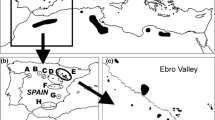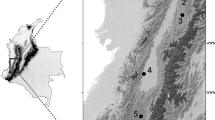Abstract
We examined complex geographical patterns in the morphology of a kleptoparasitic spider, Argyrodes kumadai, across its distributional range in Japan. To disentangle biotic and abiotic factors underlying morphological variation, latitudinal trends were investigated in two traits, body size and relative leg length, across separate transition zones for host use and voltinism. Statistical analyses revealed complex sawtooth clines. Adult body size dramatically changed at the transition zones for host use and voltinism, and exhibited a latitudinal decline following the converse to Bergmann’s cline under the same host use and voltinism in both sexes. A similar pattern was observed for relative leg length in females but not in males. A genetic basis for a part of observed differences in morphology was supported by a common-garden experiment. Our data suggest that local adaptation to factors other than season length such as resource availability (here associated with host use) obscures underlying responses to latitude.





Similar content being viewed by others
References
Baba YG, Miyashita T (2005) Geographical host change in the kleptoparasitic spider Argyrodes kumadai associated with distribution of two host species. Acta Arachnol 54:75–76
Baba YG, Miyashita T (2008) Geographic variation in adult body size and voltinism in the kleptoparasitic spider, Argyrodes kumadai (Araneae: Theridiidae). Acta Arachnol 57:51–54 (in Japanese with English summary)
Baba YG, Walters RJ, Miyashita T (2007) Host-dependent differences in prey acquisition between populations of a kleptoparasitic spider Argyrodes kumadai (Araneae: Theridiidae). Ecol Entomol 32:38–44
Baba YG, Osada Y, Miyashita T (2012) The effect of host web complexity on prey stealing success in a kleptoparasitic spider mediated by locomotor performance. Anim Behav 83:1261–1268
Barrantes G, Eberhard WG (2007) The evolution of prey-wrapping behaviour in spiders. J Nat Hist 41:1631–1658
Benkman CW, Holimon WC, Smith JW (2001) The influence of a competitor on the geographic mosaic of coevolution between crossbills and lodgepole pine. Evolution 55:282–294
Blackburn TM, Gaston KJ, Loder N (1999) Geographic gradients in body size: a clarification of Bergmann’s rule. Divers Distrib 5:165–174
Burnham KP, Anderson DR (2003) Model selection and multimodel inference: a practical information-theoretic approach, 2nd edn. Springer, New York
Chida T, Tanikawa A (1999) A new species of the spider genus Argyrodes (Araneae: Theridiidae) from Japan previously misidentified with A. fissifrons. Acta Arachnol 48:31–36
Eberhard WG (1992) Notes on the ecology and behaviour of Physocyclus globosus (Araneae, Pholcidae). Bull Br Arachnol Soc 9:38–42
Elgar M, Ghaffar N, Read AF (1990) Sexual dimorphism in leg length among orb-weaving spiders—a possible role for sexual cannibalism. J Zool 222:455–470
Faber DB (1984) Sexual differences in body proportions of Zygoballus rufipes Peckham and Peckham (Araneae, Salticidae): an effect of cheliceral and leg allometry. J Arachnol 11:385–391
Faraway JJ (2006) Extending the linear model with R. Generalized linear, mixed effects and nonparametric regression models. Chapman & Hall, Boca Raton
Foellmer MW, Fairbairn DJ (2005) Selection on male size, leg length and condition during mate search in a sexually highly dimorphic orb-weaving spider. Oecologia 142:653–662
Gaston KJ (2003) The structure and dynamics of geographic ranges. Oxford University Press, Oxford
Johansson F (2003) Latitudinal shifts in body size of Enallagma cyathigerum (Odonata). J Biogeogr 30:29–34
Losos JB (1990) Ecomorphology, performance capability, and scaling of West Indian Anolis lizards: an evolutionary analysis. Ecol Monogr 60:369–388
Masaki S (1967) Geographic variation and climatic adaptation in a field cricket (Orthoptera: Gryllidae). Evolution 21:725–741
Masaki S (1978) Climatic adaptation and species status in the lawn ground cricket. Body size. Oecologia 35:343–356
McNab BK (1971) On the ecological significance of Bergmann’s rule. Ecology 52:845–854
Miyashita T (1992) Food limitation of population density in the orb-web spider, Nephila clavata. Res Popul Ecol 34:143–153
Mousseau TA (1997) Ectotherms follow the converse to Bergmann’s rule. Evolution 51:630–632
Mousseau TA, Roff DA (1989) Adaptation to seasonality in a cricket: patterns of phenotypic and genotypic variation in body size and diapause expression along a cline in season length. Evolution 43:1483–1496
Murakami Y (1983) Factors determining the prey size of the orb-web spider, Argiope amoena (L. Koch) (Argiopidae). Oecologia 57:72–77
Nylin S, Svärd L (1991) Latitudinal patterns in the size of European butterflies. Holarctic Ecol 14:192–202
Ogasawara J (1985) Life history of the particular orb-weaving spider Cyrtophora moluccensis (Araneae: Araneidae) in Sueyoshi, Okinawa Island. Masters Thesis, University of the Ryukyus, Okinawa (in Japanese)
Platnick NI (2011) The world spider catalog, version 12.0, http://research.amnh.org/entomology/spiders/Catalog/INTRO1.html
Quinn GP, Keough MJ (2002) Experimental design and data analysis for biologists. Cambridge University Press, Cambridge
Rodriguez-Jimenez A, Sarmiento CE (2008) Altitudinal distribution and body resource allocation in a high mountain social wasp (Hymenoptera: Vespidae). Neotrop Entomol 37:1–7
Roff D (1980) Optimizing development time in a seasonal environment: the ‘ups and downs’ of clinal variation. Oecologia 45:202–208
Roff D (2002) Life history evolution. Sinauer Associates, Sunderland
Rovner JS (1980) Morphological and ethological adaptations for prey capture in wolf spiders (Araneae, Lycosidae). J Arachnol 8:201–215
Shinkai A (2001) Records of expanded distribution of Cyrtophora moluccensis. Kishidaia 80:50–56 (In Japanese)
Stearns SC (1992) The evolution of life histories. Oxford University Press, Oxford
Stillwell RC, Morse GE, Fox CW (2007) Geographic variation in body size and sexual size dimorphism of a seed-feeding beetle. Am Nat 170:358–369
Tanaka K (1984) Rate of predation by a kleptoparasitic spider, Argyrodes fissifrons, upon a large host spider, Agelena limbata. J Arachnol 12:363–367
Tanaka K (1992) Life history of the funnel-web spider Agelena limbata: web site, growth, and reproduction. Acta Arachnol 41:91–102
Tanikawa A (2005) Japanese spiders of the genus Agelena (Araneae: Agelenidae). Acta Arachnol 54:23–30
Tanikawa A, Chang YH, Tso IM (2010) Taxonomic revision of Cyrtophora spiders hitherto identified with C. moluccensis from Taiwan and Japan, using molecular and morphological data. Acta Arachnol 59:31–38
Thompson JN (1994) The coevolutionary process. University of Chicago Press, Chicago
Thompson JN (2005) The geographic mosaic of coevolution. University of Chicago Press, Chicago
Toju H, Sota T (2006) Imbalance of predator and prey armament: geographic clines in phenotypic interface and natural selection. Am Nat 167:105–117
Wise DH (1993) Spiders in ecological webs. Cambridge University Press, Cambridge
Acknowledgments
We thank Yoh Ihara, Teruo Irie, Takahide Kamura, Yasunori Maezono, Kiyoto Ogata, Akio Tanikawa and Yuya Watari for providing specimens and living spiders for analysis, and Nobuo Tsurusaki for comments on the manuscript. We especially thank the staff of the Amami Wildlife Conservation Center for their hospitality and assistance with fieldwork on Amami-oshima. We also acknowledge members of the Laboratory of Biodiversity Science, especially Masanobu Yoshio, for support. This study was supported by a fellowship from the Japan Society for the Promotion of Science for Young Scientists (JSPS 17-11551). RW was supported by a JSPS Short-Term Fellowship Award.
Author information
Authors and Affiliations
Corresponding author
Rights and permissions
About this article
Cite this article
Baba, Y.G., Walters, R.J. & Miyashita, T. Complex latitudinal variation in the morphology of the kleptoparasitic spider Argyrodes kumadai associated with host use and climatic conditions. Popul Ecol 55, 43–51 (2013). https://doi.org/10.1007/s10144-012-0334-5
Received:
Accepted:
Published:
Issue Date:
DOI: https://doi.org/10.1007/s10144-012-0334-5




